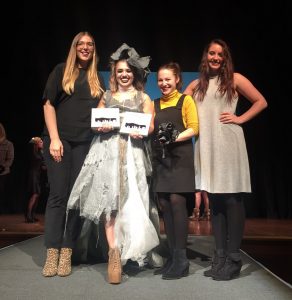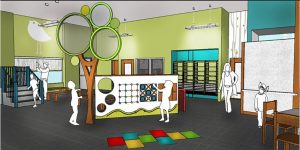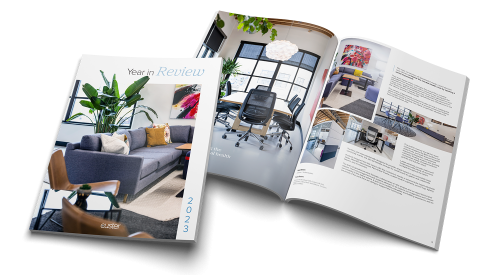- Blog
- Q&A with Tara McCrackin, KCAD Interior Design Chair & IIDA Michigan President-Elect
Q&A with Tara McCrackin, KCAD Interior Design Chair & IIDA Michigan President-Elect

 Tara McCrackin wears many hats as both an educator and interior designer. Soon her numerous leadership titles will include President of IIDA Michigan.
Tara McCrackin wears many hats as both an educator and interior designer. Soon her numerous leadership titles will include President of IIDA Michigan.
As part of our ongoing Q&A series with industry professionals, we sat down with Tara McCrackin, Kendall College of Art & Design’s Interior Design Program Chair and Assistant Professor, and President-Elect of the IIDA Michigan Chapter. A proven leader in interior design and design education, Tara began teaching in the interior design department at KCAD in 2000, which was only three years after being a student of the department herself. Having originally graduated with a fine arts degree, she later pursued a teaching certificate — “Then when I was student teaching I thought to myself, I don’t want to teach,” she says — and later went on to pursue an interior design degree. “Because I was a nontraditional student to begin with, three years out of school I was not twenty-five,” she said of her transition from school. With her teaching background and the professional experience she brought to her second career, Tara was soon called by Interior Design Program Chair to teach night classes at Kendall. Now, nearly twenty years later, her practice in fine arts, teaching, and design all come together for the good of her students and her alma mater.
In this rich Q&A, Tara allows us an insider’s view into the wisdom and experience gained in her career thus far; not to mention the best advice she’s ever received, her ideas for educating the public on interior design, and a brilliant idea for combining wine and 3D printing. Read on!
In your 20 years in the profession, how have you seen interior design evolve?
I like to think — and this doesn’t happen on every project, but I think it happens on the most successful projects — that interior design is considered earlier in the process, and is not something to add on at the end, or to work around the problems that have been set earlier. So it’s much more collaborative. And I think the customers and the other professionals on the team, for the most part, recognize the value of having design earlier in the process brings. So it’s much less a linear, defined schedule than what it was historically. And I think you could say the same thing for architecture as well. And I think LEED, looking at the integrated design process, sort of mixed things up and got people looking at opportunities and impacts earlier in the process, kind of reconsidering how we get the most success for our dollars.
I think the average customer, the average person, is more attuned to how design impacts their everyday life, and how it can impact productivity and how they feel. And that might be because I have an insular life and everyone I know is working in the field, but it’s not groundbreaking research. I always tell students, when they get the canned, “bring the outdoors in,” there really is research that says access to daylight increases productivity, makes you have more energy, feel better about yourself — there really is something to that cliché. But let’s not make that so cliché — how do we make that more sophisticated?
 Here, a team of KCAD Interior Design students present their Best of Show piece at the IIDA Finish2Fashion Competition in November 2016.
Here, a team of KCAD Interior Design students present their Best of Show piece at the IIDA Finish2Fashion Competition in November 2016.
To build off of that, I’m curious — how has your own work changed as a practicing interior designer?
I think this is true for any seasoned designer: that the work becomes more conceptual and I’m willing to push the envelope, take more risks. It’s not so much focused on what things can do. I think coming out of school in order to work for the manufacturers, you have to learn to break all the rules. I was doing showroom design, which is all about showcasing product. And then working with the architect was more about thinking holistically about the environment and less about the product. And I would say that that translates into what I do now. In the classroom it’s more about the function and the idea and the envelope than the thing.
Which is all the more reason for these trades to be integrated — out of necessity. What trends do you anticipate for interior design in the next 5-10 years?
Exploration of materiality and texture. I think with technology and the whole maker movement, we’re going to push the envelope on things that were traditionally flooring materials or traditionally wall surfaces, textiles, 3D printing. We’re going to see things really pushed and pulled. And I won’t say color is less important, because color is always important, but there’s a new color of the year every year and it’s been pretty neutral — even this year it’s greenery. I’ve been saying for ten years that green is a neutral. If you look at mother nature, it’s the basis. It’s about harmony. And I think exploring textures and materials really supports that feeling, which I think we’re going to have around for a while.
What would be an example of that trend?
I think 3D printing. We’re already seeing it impact fashion and packaging, and conceptually you can 3D print a structure. So I think we’re going to see materials that are 3D printed, objects that are 3D printed. They are already seating and side tables, but I think we’ll see a big push. And it might even be sort of — this is corny — they have the painting studios you know, where you go in and take your glass of wine and paint. Maybe you’ll take your idea and will be able to 3D print it. And it will probably be based on some classic piece that has a shape and form that is easily replicated or manipulated to be slightly different.
How do you see interior design interacting with other art disciplines?
Well, certainly branding and messaging. When we look at corporate and healthcare and hospitality, where we see a blend in that resi-mercial, if you don’t think about the artwork as part of your solution, it becomes the thing that first is eliminated from the budget, and then later a poster is put up — something that doesn’t have any relevance to the project or any placemaking. So thinking about it from an integrated approach really helps finish the space. Because we’ve all seen those projects that don’t have anything staged, and it looks incomplete, because all the parts and pieces to support what’s happening are there, but not the touches that make it unique. And of course photography, and the whole maker movement– how can I make this my own? If you look at home decor, which is not what I do a lot of, the finger-knit throws are all about texture and about the pride of having made that yourself. And that’s impactful in an interior because it has a distinct and a fun aesthetic — and a story. And the things that can make it unique, your own; artwork is the thing that differentiates your Eames chair from somebody else’s.
 While a student of KCAD’s interior design program, Sharon Shlueter designed this active zone for children.
While a student of KCAD’s interior design program, Sharon Shlueter designed this active zone for children.
What unique gifts, skills, & experiences do you see KCAD students bringing to our community?
If you look at any of the design firms, Kendall interior design students are represented. We have a large alumni base. And I have employers that have no connection to Kendall who call me and say “I need a Kendall person.” I love to hear that, and I always ask, “Why, what do you know about Kendall?” I think because we’re a BFA program, which is one of our differentiators, our students are well prepared to visually tell the story and package the solution in ways that are dramatic, emotive, and really capture and differentiate a project. I think that makes the impact. Now, making it pretty is not…. Not only do we have good design, and good design skills, but we can package that well to tell the story visually.
You are the president-elect for the IIDA (International Interior Design Association) Michigan chapter. What priorities are you bringing to that role?
I’m stepping into that role from having been, for five years, the VP of Student Affairs; they lobbed me a softball “How can we get students more involved?” IIDA headquarters is focusing on how to get students involved, because students are really the future of design. And I would say that the IIDA Michigan chapter is ahead of most chapters in North America because we’ve been focused on students. We have student competitions that we sponsor or have sponsored, two or three every year, and students are welcome in all our events – and they come. Because of my previous role I know students and faculty at Michigan State, and at Western Michigan, and at CCS (College for Creative Studies), and at Central Michigan; so when they come, I make sure they don’t just hang out together, because they came to network. So I might make the first introduction and encourage them to divide, and to talk to other professional designers. So I would say that IIDA is focused on education and student opportunities. IIDA members are required to do CEUs, and IIDA is focused on providing those opportunities to our members and others, to grow our membership and our connections. And we’ve also been focused on connecting with other professional organizations, like partnering with Design West Michigan, looking at opportunities with AIA and USGBC and ASID. So I think the priorities will be to grow and maintain that, and to promote the profession. Ultimately that’s what IIDA is about, to promote the profession now and to communicate things about legislation — Michigan has nothing that recognizes interior design, while other states do — and share what we’ve learned from other states and build allies. I think one of our biggest challenges is educating the public on what interior design does, and HGTV does not help us in that respect. I’ve been called a decorator on more projects than I…. And yes, the decorator parts are a part of what we do, but it’s actually a small part of what an interior designer does.
As an educator, and with your interior design background, what does it look like to educate the public about your role as an interior designer and the profession?
We’ve got a long ways to go. I won’t say it’s insurmountable. In certain areas of the country, certain areas even of Michigan, are much more aware of what design, design thinking, and design strategy are. So there’s relevance. But we don’t have an active coalition in Michigan .So we as IIDA, because there is no active coalition, focused our efforts on education and certification. The more NCIDQ-certified designers we have in Michigan, the bigger our numbers, the more power and recognition we can have. And IIDA recognizes that. They recently did a salary survey and those that have certification, on average, earn twenty percent more than peers without it. So even though there’s nothing requiring a designer in Michigan, unless you’re working out of the state as many are because of technology and globalization, it needs to be a personal, professional goal.
What has been your proudest moment?
I could say the students that go out and win these big competitions. We just had a student that won a big international design competition and went to Orgatec in October, where her design was built. That’s wow. But I think I’m most proud of the students that come in a little rough and figure it out. I might have them their sophomore year, when they’re first introduced to workplace design. Most students come thinking they want to do residential, until they learn more about design. We spend ninety percent of our time indoors, and that’s not all at home. And some absolutely hate — the whole modular office system, and thinking in that bigger, grander scale with a bigger floor plate than a living room. They absolutely hate it. And then I’ll get them again two years later, and all those hard edges are polished, and this is what they want to do. There’s one class where I’ll really see them put it together….And that gets me really excited. That’s why I keep teaching. So we’ve got all these great success stories, but it’s really the ones that come in trying to figure it out that get it figured out and really succeed that I’m proudest of.
What’s the best advice you’ve ever received?
One I perpetually reference and share with students is, you’re going to have a problem with every design project — whether that’s with the client, interpersonal relationships, the project, or in the construction. Humans are involved, so there’s going to be an error somewhere. So the intent is not to point fingers but to find solutions. So , this is what happened, what can we do, how can we move on? Not who’s responsible and what are you going to do about it? Instead of going backwards, let’s move forward. Because we’re all going to make mistakes. It happens, and it costs money and time. And nobody feels good about it. Move on. Resolve it. Learn from it. You won’t make that mistake again. And I encourage students to share the mistakes they make, and that while it can be a competitive field, go back to the office and say “Hey, has this ever happened? Because it really sucks and I didn’t know about this.” Share that so other designers don’t have to learn the hard way.
That’s good advice for any industry.
It’s a waste of energy and time to find fault. Let’s find a solution.
For more information on Tara and KCAD’s interior design program, visit their website.
Do you have other questions for Tara? Ideas for other professionals who would be great for our Q&A series? Share in the comments below!


